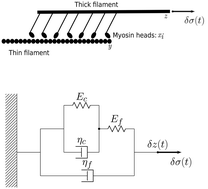Passive viscoelastic response of striated muscles†
Abstract
Muscle cells with sarcomeric structure exhibit highly non trivial passive mechanical response. The difficulty of its continuum modeling is due to the presence of long-range interactions transmitted by extended protein skeleton. To build a rheological model for muscle ‘material’, we use a stochastic micromodel, and derive a linear response theory for a half-sarcomere, which can be extended to the whole fibre. Instead of the first order rheological equation, anticipated by Hill on the phenomenological grounds, we obtain a novel second order equation which shows that tension depends not only on its current length and the velocity of stretching, but also on its acceleration. Expressing the model in terms of elementary rheological elements, we show that one contribution to the visco-elastic properties of the fibre originates in cross-bridges, while the other can be linked to inert elements which move in the sarcoplasm. We apply this model to explain the striking qualitative difference between the relaxation in experiments involving perturbation of length vs. those involving perturbation of force, and we use the values of the microscopic parameters for frog muscles to show that the model is in excellent quantitative agreement with physiological experiments.



 Please wait while we load your content...
Please wait while we load your content...